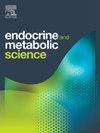The effectiveness of Rosuvastatin in controlling LDL-C and non-HDL-C levels in hypertensive patients with or without diabetes mellitus
Q3 Medicine
引用次数: 0
Abstract
Background
LDL-C and non-HDL-C are contributing risk factors in the development of cardiovascular disease and stroke, exacerbating hazardous cardiovascular events. Rosuvastatin is a widely used statin globally, and a thorough assessment of its efficacy in hypertensive patients with or without diabetes mellitus is essential.
Objectives
This study aims to compare the efficacy of Rosuvastatin 20 mg in controlling LDL-C and non-HDL-C in hypertensive patients with and without diabetes.
Methods
A cross-sectional descriptive study on 126 primary hypertensive patients (72 hypertensive patients with diabetes and 54 hypertensive patients without diabetes) treated with Rosuvastatin based on cardiovascular risk stratification according to SCORE to assess the efficiency of achieving treatment targets.
Results
In hypertensive patients without diabetes (n = 54; 42.9 %), the average age was higher (63.52 ± 8.68 years) and predominantly female (70.4 %) compared to those with diabetes (n = 72; 57.1 %). After 12 weeks of Rosuvastatin 20 mg treatment, non-diabetic patients exhibited more significant improvements in lipid profiles, notably marked decreases in LDL-C and non-HDL-C levels (p < 0.001). The treatment targets for LDL-C were achieved by 27.8 % of diabetic patients and 20.4 % of non-diabetic patients, while the targets for non-HDL-C were achieved by 40.3 % of diabetic patients and 41.5 % of non-diabetic patients. History of stroke and coronary artery disease was significantly associated with increased LDL-C and non-HDL-C in both pre-and post-treatment in both groups.
Conclusion
The utilization of Rosuvastatin 20 mg has shown efficacy in ameliorating elevated LDL-C and non-HDL-C levels in primary hypertensive patients. Specifically, in the hypertensive group without diabetes, Rosuvastatin 20 mg aids in better control of LDL-C and non-HDL-C compared to the hypertensive group with diabetes.
瑞舒伐他汀控制合并或不合并糖尿病的高血压患者LDL-C和非hdl - c水平的有效性
背景:ldl - c和非hdl - c是心血管疾病和中风发生的危险因素,加剧了危险的心血管事件。瑞舒伐他汀是全球广泛使用的他汀类药物,全面评估其对合并或不合并糖尿病的高血压患者的疗效至关重要。目的比较瑞舒伐他汀20mg对合并和不合并糖尿病的高血压患者LDL-C和非hdl - c的控制效果。方法对126例原发性高血压患者(伴有糖尿病的高血压患者72例,无糖尿病的高血压患者54例)进行基于心血管危险分层(SCORE)的横断面描述性研究,评价瑞舒伐他汀治疗的疗效。结果无糖尿病的高血压患者54例;42.9%),平均年龄(63.52±8.68岁)高于糖尿病患者(n = 72;57.1%)。瑞舒伐他汀20mg治疗12周后,非糖尿病患者的脂质谱表现出更显著的改善,LDL-C和非hdl - c水平显著降低(p <;0.001)。27.8%的糖尿病患者和20.4%的非糖尿病患者达到了LDL-C的治疗目标,40.3%的糖尿病患者和41.5%的非糖尿病患者达到了非hdl - c的治疗目标。卒中和冠状动脉疾病史与两组治疗前后LDL-C和非hdl - c升高显著相关。结论瑞舒伐他汀20mg可有效改善原发性高血压患者LDL-C和非hdl - c水平升高。具体来说,在没有糖尿病的高血压组中,瑞舒伐他汀20mg比高血压合并糖尿病组更有助于控制LDL-C和非hdl - c。
本文章由计算机程序翻译,如有差异,请以英文原文为准。
求助全文
约1分钟内获得全文
求助全文
来源期刊

Endocrine and Metabolic Science
Medicine-Endocrinology, Diabetes and Metabolism
CiteScore
2.80
自引率
0.00%
发文量
4
审稿时长
84 days
 求助内容:
求助内容: 应助结果提醒方式:
应助结果提醒方式:


